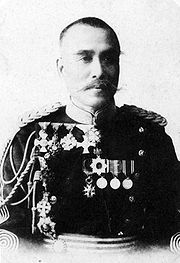- Tatsumi Naofumi
-
Tatsumi Naofumi 
Tatsumi Naofumi in his later yearsBorn August 21, 1845
Kuwana, JapanDied March 6, 1907 (aged 61)
Tokyo, JapanAllegiance Empire of Japan Service/branch  Imperial Japanese Army
Imperial Japanese ArmyRank General Commands held Shinsenryodan, Army War College, 8th Infantry Division Battles/wars Boshin War
*Battle of Kaminarizuka
Satsuma Rebellion
First Sino-Japanese War
*Battle of Pyongyang
Russo-Japanese War
*Battle of Sandepu
*Battle of MukdenIn this Japanese name, the family name is "Tatsumi".Tatsumi Naofumi (立見 尚文, 21 August 1845 – 6 March 1907) was a general in the Imperial Japanese Army during the Meiji period.[1]
Contents
Early life
Also known as Tatsumi Kanzaburō (立見鑑三郎) in his youth, Tatsumi was born in the Kuwana domain's (Ise Province, present-day Mie Prefecture) Edo residence, to Kuwana retainer Machida Dendayu, and was later adopted by his uncle, Tatsumi Johei. At age five, the young Tatsumi went to Kuwana with his adoptive father, and at age 8 entered the domain school, Rikkyokan, studying literature and martial arts, and receiving a commendation for academic excellence at age 15. Soon after, Matsudaira Sadaaki became daimyo of Kuwana, and Tatsumi became his page, with a 180 koku stipend. Together with Matsudaira Sadaaki, he left for Edo in 1861, where was permitted to attend the elite Shogunate school at Shoheiko, and where he was hailed as a prodigy.
Soldier in the Boshin War
When Matsudaira Sadaaki was appointed as Kyoto Shoshidai, Tatsumi followed him to Kyoto, where he served as a liaison with other domains. It was in this role that he met many of the men who would later become famous in the Meiji period, including Katsura Kogoro, Ōkubo Toshimichi, and Saigō Takamori. Before long, though, he was transferred back to Edo and entered the Tokugawa bakufu's French-trained infantry. His French military instructors were said to have remarked, "Tatsumi is a genius of a soldier." He later served in the Bakufu's 3rd Infantry Regiment.
During the Battle of Toba-Fushimi, he was in Edo. When Matsudaira Sadaaki returned, Tatsumi advocated continued military opposition to the Imperial army. He followed his lord, and the Kuwana retainers remaining in Edo, and to Echigo Province by sea, where they hoped to establish themselves in the former Shogunal territory of Kashiwazaki. Tatsumi organized the remaining Kuwana retainers into three units—the Raijintai, the Jinputai, and the Chinintai. Elections were held to determine the commanders of each unit, and Tatsumi became commander of the Raijintai, and his elder brother Machida Ronoshin became commander of the Jinputai. Through well-coordinated guerilla tactics, Tatsumi managed to fight his way to Kashiwazaki. Joining up with Matsudaira Sadaaki in Kashiwazaki, he continued to fight against the new government's army, first independently, and then in concert with the Nagaoka domain. However, when Nagaoka was defeated, the Kuwana forces went further north, to Aizu, the domain of Matsudaira Sadaaki's birth brother, Matsudaira Katamori. Tatsumi fought in the Aizu campaign, and led the Kuwana forces north on Matsudaira Sadaaki's orders, surrendering in the Shonai domain some time later.
Under the Meiji government
Following the end of the Boshin War, Tatsumi was placed in confinement, and changed his given name to Naofumi. Pardoned by the new government, Tatsumi joined the Imperial Japanese Army. He served as chief-of-staff of the Shinsenryodan, a unit composed of former Kuwana retainers and members of the Shinsengumi, in the Satsuma Rebellion.
He was a senior officer in the First Sino-Japanese War, distinguished by his role in the 1894 Battle of Pyongyang.[1]
During the Russo-Japanese War, he was commander of the 8th Infantry Division. Two of the principal battles of his military career were at Sandepu and Mukden in 1905.[1]
He later served as head of the Army War College and as head of Japanese forces in Taiwan. He was ennobled with the rank of danshaku (baron) under the kazoku peerage system.
Notes
References
- Dupuy, Trevor Nevitt, Curt Johnson, David L. Bongard. (1992). The Harper Encyclopedia of Military Biography. New York: HarperCollins. 10-ISBN 0062700154/13-ISBN 9780062700155; OCLC 243724947
- Jansen, Marius B. (2000). The Making of Modern Japan. Cambridge: Harvard University Press. 10-ISBN 0674003349/13-ISBN 9780674003347; OCLC 44090600
External links
Wikimedia Foundation. 2010.
